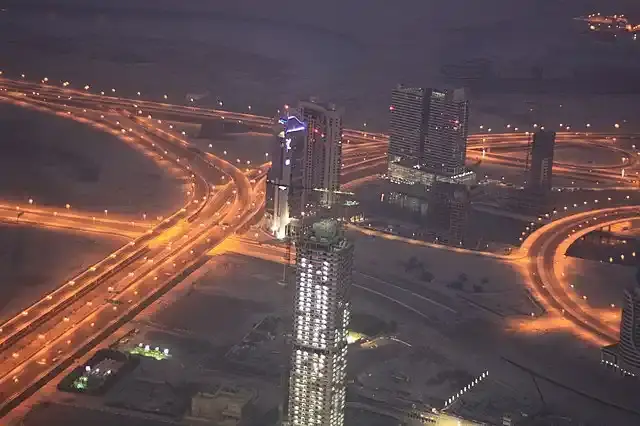The story of building the tallest tower in the world. Burj Khalifa in Dubai
Burj Khalifa ... Dubai City Code

Burj Khalifa in Dubai is the tallest building in the world, weighing nearly half a million tons, this skyscraper is made of steel enough to cover a quarter of the Earth's circumference, but without the advanced infrastructure, such a building would never have been possible. The engineers owned the shield and abandoned their plans during the implementation and continued to increase the height, and today the tower stands despite the fears of others / and the engineers who are in its construction are still proud to participate in this wonderful engineering work. Let's find out some of the secrets of this wonderful geometric construction.
Show key points
- The Burj Khalifa in Dubai is the tallest building in the world, weighing nearly half a million tons and built with enough steel to encircle a quarter of the Earth.
- Initially envisioned as a symbol of Dubai's ambition to become the global tourism capital, the tower was constructed on challenging desert land composed largely of sand.
- World-renowned structural engineer Bill Baker led a team that had to overcome the geologically unstable foundation, which consisted of sedimentary calcilitite rock.
- ADVERTISEMENT
- Engineers devised a unique “floating foundation” that distributes weight over a 7,500-square-meter area using concrete slabs
- 5 meters thick and 7 meters deep.
- The foundation’s stability relies on friction piles, allowing only a minimal settlement of around 5 centimeters after the building's completion.
- With a solid base established, the structure continued to rise at an incredible pace of one floor every three days, using a specialized method of pouring liquid cement.
- Despite the magnitude of the challenge, the Burj Khalifa was completed successfully, and the engineers remain proud of contributing to this iconic marvel of modern architecture.
The beginning of the design and the goal of the construction of the Burj Khalifa
Recommend

This giant tower was designed to be a basic emblem for the city of Dubai, which aspires to be the capital of tourism in the world, but the nature of its land was not ideal for building such giant buildings, it is a very hot and very dry place, and when it was thought to build the tower in 2003, that land from Dubai was nothing more than sand, and to make this ambitious project see the light, a team of the best engineers in the world was formed under the leadership of an expert engineer Global skyscrapers "Bill Baker".
The genius of the Burj Khalifa construction team

It was obvious that the team began to study the construction site of the tower to find out the nature of the land on which the tower will be built, so they dug holes tens of meters deep and the results were worse than they expected as they found a huge sedimentary rock called "Calcilitite" which means "sandy sea shells", so this was a big problem that increases the difficulty of the project as there is no rock base that can withstand the huge tons that will be lifted on those foundations, and therefore the tower will not withstand without a foundation base Able to carry those huge weights, otherwise what happened to the Leaning Tower of Pisa happened to him and his fate may end up collapsing if the inclination exceeds a certain degree.
Overcoming geological problems on the floor of the Burj Khalifa

The solution devised by the team was a genius solution, where the Burj Khalifa stands on concrete foundations 3 and a half meters thick, stretching seven meters deep underground, covering an area of 7,500 square meters (the size of 28 tennis courts), and this is called "floating foundation" as it floats on loose ground. To represent it, you can imagine walking on grass with high heels and thin, the heel will be planted in the grass ground and a fall may occur backwards, but imagine wearing flat shoes, the fall will not occur because the pressure will decrease and distribute. And this is the role played by the floating foundation. Weight distribution is good n But the foundation must be fixed so as not to lead to the tilt of the tower and then its collapse.
Unlike traditional piles, the floating foundation derives its stability from friction, as friction is a large force applied suddenly, and the presence of a sufficient number of pillars that derive their stability from friction will secure a total of the forces of the pillars sufficient to carry the tower, and one of the largest evidence of the ideal floating foundation that was used in the construction of the Burj Khalifa is that the building has dived a distance of only two thumbs after its completion (equivalent to approximately 5 centimeters), which is an impressive rate for a building with this Size and weight.
Engineers have overcome the obstacle of unstable land in the desert, but they still have more than 800 meters of height vertically, as the strong foundation alone is not enough to build the tallest tower in the world, and what made it more difficult was that the Burj Khalifa was built of cement, which increased the weight of the building, and is made in a way that allows pouring liquid cement inside it, and then moving to the next floor, so a floor was built every 3 days in this way, which is a very fast rate compared to the size of the building, but it gets more difficult the higher the building.








